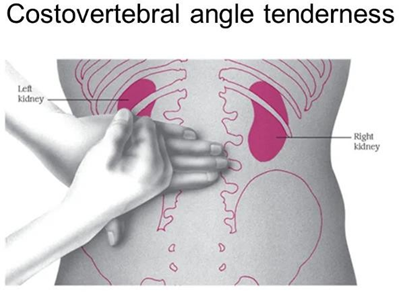A client comes to the Urgent Care center complaining of urinary frequency accompanied by pain when voiding. Which clinical manifestation would make the nurse suspect acute pyelonephritis rather than cystitis?
Urinary urgency
Increased WBCs in urinalysis
Costovertebral tenderness
Hematuria
The Correct Answer is C
C. Costovertebral tenderness, which is tenderness over the costovertebral angle (where the ribs meet the vertebral column) on palpation, is more indicative of acute pyelonephritis rather than cystitis. In acute pyelonephritis, inflammation of the kidney parenchyma and surrounding tissues can lead to tenderness in this area.

A. Both acute pyelonephritis and cystitis can present with urinary urgency, as it is a common symptom of urinary tract infections (UTIs) in general.
B. Increased WBCs in urinalysis: While an increased number of white blood cells (WBCs) in the urinalysis can indicate a urinary tract infection, it is not specific to either acute pyelonephritis or cystitis.
D. Hematuria can occur in both acute pyelonephritis and cystitis.
Nursing Test Bank
Naxlex Comprehensive Predictor Exams
Related Questions
Correct Answer is B
Explanation
B. Large amounts of IV saline solution: This is the correct initial therapy. HHNK is characterized by severe dehydration due to osmotic diuresis resulting from hyperglycemia. Therefore, the administration of large amounts of IV saline solution is essential to correct dehydration, restore intravascular volume, and improve tissue perfusion.
A. Glucagon is typically administered to treat severe hypoglycemia, not hyperglycemia.
C. Short-acting or regular insulin is administered initially to lower blood glucose levels rapidly. Long-acting insulin formulations may be used later to maintain glycemic control once the acute phase is managed.
D. Oxygen therapy may be indicated if the client is hypoxic, but it is not the initial therapy for HHNK. The priority in HHNK is to correct dehydration and hyperglycemia through fluid resuscitation and insulin therapy, respectively.
Correct Answer is C
Explanation
C. Decrease the rate to 27.1 mL/hr until the new bag is brought to the unit: This option is a suitable approach to conserve the remaining TPN solution until the new bag arrives. By halving the infusion rate, the remaining volume of TPN will last longer, ensuring the client continues to receive some nutrition and fluid support while awaiting the delivery of the new bag.
A. While it's important to inform the healthcare team about the low volume of TPN remaining, it may not require immediate physician intervention unless the situation worsens or alternative actions need to be taken.
B. Notifying the pharmacy when the bag is empty is a reasonable action, as they can prepare and deliver the next infusion bag promptly. However, it does not address the immediate need for fluid and nutrition replacement.
D. D10W (dextrose 10% in water) can help prevent hypoglycemia and provide some energy, but it does not provide the full nutritional support that TPN does. However, it can be a reasonable short- term measure while waiting for the replacement TPN bag.
Whether you are a student looking to ace your exams or a practicing nurse seeking to enhance your expertise , our nursing education contents will empower you with the confidence and competence to make a difference in the lives of patients and become a respected leader in the healthcare field.
Visit Naxlex, invest in your future and unlock endless possibilities with our unparalleled nursing education contents today
Report Wrong Answer on the Current Question
Do you disagree with the answer? If yes, what is your expected answer? Explain.
Kindly be descriptive with the issue you are facing.
